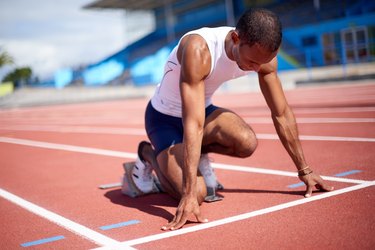
If you're the type of person who won't let sky-high temperatures stop you from your training run, tennis game or hike, you could be putting yourself at risk for heat-related illness.
Hot, humid weather can be particularly nasty for summer exercisers. Overdo it and you could face heatstroke, a potentially life-threatening condition that requires emergency medical help.
Video of the Day
Video of the Day
Before you reach that point, it's important to know the signs and symptoms of heat illness and exhaustion. Spotting them could save your — or someone else's — life.
What Is Heatstroke?
"Heatstroke develops when the body's systems are overwhelmed by heat and begin to stop functioning," says Jonathan L. Epstein, senior director of Science, Industry and Government Relations for the American Red Cross, Training Services. This happens as the body temperature reaches 103 degrees Fahrenheit, according to the Centers for Disease Control and Prevention (CDC).
If you're working out — especially if you're pushing your pace or really exerting yourself — you need more fluids as the mercury rises. "Hot weather only exacerbates the body's need for hydration and electrolytes when it exerts energy," Epstein says.
The Warning Signs of Heatstroke
The best way to avoid heatstroke is to prevent the progression of heat-related illness in the first place. That means listening to your body in the early stages and looking out for the heatstroke symptoms below.
Heat Cramps
The first symptom you might notice are heat cramps, which includes muscle cramps in the legs and abdomen, heavy sweating, fatigue and thirst, according to the National Library of Medicine. You may feel like you can keep going, but don't be a hero. Stop, rest, drink an electrolyte-containing sports drink and stay on the sidelines until cramps and spasms go away, per the CDC.
Clammy Skin
Some of the symptoms of heat cramps hardly sound remarkable — you're hoofing it in the heat, of course you're going to be tired and sweaty. But if you keep going, then the problem will progress into heat exhaustion, a more serious form of heat illness.
"Physical warning signs of progression include cool, moist, pale or flushed skin, headache, nausea and dizziness," Epstein says. If your skin feels cold and clammy, move to a cool spot and hydrate with water, according to the CDC. Now is the time for recovery.
Warning
“Heatstroke usually develops from ignoring the symptoms of heat exhaustion,” Epstein says.
Vomiting
When you were in high school, exercising so hard you vomited may have gotten you a pat on the back. It's a danger sign when it comes to heat illness.
According to the American Council on Exercise, heat exhaustion has two parts: water depletion (leading to symptoms like thirst, weakness and headache) and salt depletion, which causes muscle cramps, dizziness, nausea and vomiting.
Throwing up is a clear signal you need to stop what you're doing and seek a shady spot (or better yet, indoors in the air-conditioning), loosen tight clothing and apply cool compresses to your body. If you're vomiting, you need to seek help immediately. Call 911.
Weak or Rapid Heart Rate
Heatstroke can also mess with your heart rate. Heat exhaustion can cause a weak pulse, while a fast, strong pulse is more indicative of a heatstroke, per the CDC. Either way, something is wrong.
Confusion
Heatstroke can be mentally disorienting. "Heat illness can make people confused, dizzy, exhausted and even unconscious," Epstein says. Your behavior may be odd, but because of this mental shift, you may not realize something's very wrong. That's why the buddy system can come in handy when exercising in the heat. Plus, it's often more fun to tackle that sweaty 5-miler with a friend, anyway.
Speaking of, if it's a friend you're worried about, ask yourself if they're acting off. Do they know where they are? What they're doing? Are they seeing something that isn't there? Acting extremely irritable? If you suspect a heat illness, stick by their side.
"People who are experiencing heat illness should not be alone; they should be with someone who can monitor their condition," Epstein says. If they have other signs and symptoms of heatstroke, call 911.
Fainting
If your exercise buddy loses consciousness, it should be fairly obvious that you're in emergency territory. Don't wait, call 911 for help.
Warning
Yes, “call 911” has been repeated over and over, but it’s that important. This is not a wait-and-see illness. Heatstroke is serious and can lead to brain and organ damage and death.
How to Prevent Heatstroke
First, know the symptoms of heatstroke and heat exhaustion and take steps to swiftly and adequately treat them (resting, seeking shade).
Lessen your risk in the first place by staying hydrated before and during exercise, avoiding working out outside during the hottest parts of the day (the sun is at its peak between 10 a.m. and 2 p.m.) and condition your body for exercising outdoors in the heat, per the Mayo Clinic. (Now is not the time to suddenly take your half-marathon training runs from the treadmill to the trails. Your body needs time to slowly acclimate.)
To stay safe in the heat and stay up to date on heat waves, you can also download the free Red Cross Emergency App (Apple, Google Play).
Was this article helpful?
150 Characters Max
0/150
Thank you for sharing!
Thank you for your feedback!
Is this an emergency? If you are experiencing serious medical symptoms, please see the National Library of Medicine’s list of signs you need emergency medical attention or call 911.